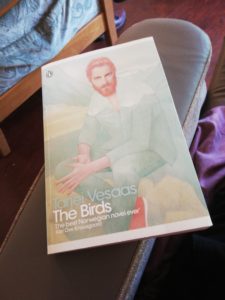“What can you do when everyone around you is strong and clever?”
Tarjei Vesaas, The Birds (1957)
Translated from the Norwegian by Tørbjorn Støverud and Michael Barnes (1968)
Tarjei Vesaas’ The Ice Palace was one of the stand-out books I read a couple of years ago, so it was a pleasure to read another of his novels and find it similarly affecting.
Our viewpoint character this time is 37-year-old Mattis, who lives with his older sister Hege in a cottage by the lake. The locals call him ‘Simple Simon’, and he doesn’t have much luck – either with getting women to notice him, or finding work. At one point, we see him join in with thinning out the rows of turnips on a local farm, but he simply can’t keep up.
There’s always the possibility that things will change, though. Towards the beginning of the novel, Mattis sees a woodcock fly directly over the house. He’s never seen one do that before. Mattis’s world is reordered: “It seemed to be a different house now, you had to look at it with different eyes.” He is eager to tell Hege what’s happened, but her reaction is a weary, “go and get some sleep now, Mattis.”
This is the way life tends to go for Mattis: things that mean so much to him leave others indifferent, and he can’t understand why. As readers, we can share his delight and frustration, but we can also see how difficult Hege has found it living with him – even though she doesn’t want to let it show.
***
There are a couple of chapters in the middle of The Birds that I think will go down as one of my favourite sequences in fiction. Mattis has been out in his boat and become stranded. He is found by a couple of holidaying girls, Anna and Inger, who take him back to shore. I was stunned by the range of emotions covered with such subtlety in these scenes. You see so much all at once.
Mattis is innocently overjoyed that finally some girls have paid attention to him. What’s more, they don’t know him, so he can revel in the freedom of being someone else. At the same time, his wandering eye and emotional intensity make Anna and Inger uncomfortable. But they also feel it would be wrong to leave him there. The sense is that they know on one level that Mattis means no harm, but on another they are instinctively wary of him. Vesaas makes clear that all these emotional contradictions are bound up together, and the tension between them helps give these scenes their power.
***
Mattis later tries to earn a living as a ferryman, but ends up with only one passenger: Jørgen, a lumberjack. Jørgen needs a bed for the night, so Mattis invites him back to the cottage – and there the lumberjack stays, because Hege falls in love with him. Now the balance of Mattis’s life is upended, and he has to work out his place in the world anew.
The touchstones of Mattis’s world – small events in nature, Hege and her constant knitting – are not those of other people. This is what makes it so difficult for him to relate to others, and them to him. But there are still times when he wants to ask the big questions – “Why are things the way they are?” – if someone would only listen. Vesaas depicts Mattis and his life with piercing clarity.
The Birds is published in the UK by Penguin Modern Classics (in association with Peter Owen Publishers), and in the US by Archipelago Books.

8th May 2020 at 10:09 am
The only Vesaas I’ve read is Boat in the Evening which I found a bit disappointing but I should give some if his more famous novels like this a try.
23rd May 2020 at 2:49 pm
I’ve read what I guess must be the two most famous ones now, and loved them both. I would definitely give him another go.